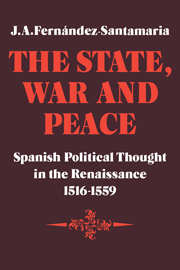Book contents
- Frontmatter
- Contents
- Abbreviations
- Acknowledgments
- Introduction
- PART I MEDIEVAL CONSTITUTIONALISM, CHRISTIAN HUMANISM, AND NEOSCHOLASTICISM (1516–1539)
- 1 The opposition to empire: Alonso de Castrillo
- 2 Advocates for empire
- 3 The discovery of America and the School of Salamanca: Francisco de Vitoria (I)
- 4 Francisco de Vitoria (II)
- 5 The age of Erasmus on war and peace
- Part II THE WANING OF ERASMIANISM (1539–1559)
- Bibliography
- Index
5 - The age of Erasmus on war and peace
Published online by Cambridge University Press: 07 October 2011
- Frontmatter
- Contents
- Abbreviations
- Acknowledgments
- Introduction
- PART I MEDIEVAL CONSTITUTIONALISM, CHRISTIAN HUMANISM, AND NEOSCHOLASTICISM (1516–1539)
- 1 The opposition to empire: Alonso de Castrillo
- 2 Advocates for empire
- 3 The discovery of America and the School of Salamanca: Francisco de Vitoria (I)
- 4 Francisco de Vitoria (II)
- 5 The age of Erasmus on war and peace
- Part II THE WANING OF ERASMIANISM (1539–1559)
- Bibliography
- Index
Summary
Introduction
The age of Erasmus struggled in countless schemes to articulate the means of restoring society to the order and tranquillity which, it was believed in some quarters, had prevailed in some remote age. And nowhere is this anxiety more poignantly expressed than among those Christian humanists who ‘strove to describe, as a model for their age, the outlines of a radically improved social order’. How melancholy the plight of European society was in their eyes is exemplified by Vives' De concordia: ‘No greater need has the world, nowadays tottering at the edge of final prostration, than for concord. Only concord will reinstate the fallen, retain what is now fleeing from us, and restore what has already been lost.’ The Vivian ‘world’, however, is but Christendom, the product of a novel intellectual tradition which preserved ‘many traditional features of the medieval schools in Renaissance attire’. For one thing, the common characteristic of the Christian humanist social blueprints is the relative parochialism which confines them to the well-known experience of Western Europe, the familiar needs of a social order based upon the acceptance of Christian values, and their failure to understand the political significance of the emerging nation-state. Incomplete as those schemes may have been before 1492, they had become totally inadequate after the discovery of new territories and peoples across the ocean. This shortcoming of Christian ideology is a serious one, as we shall fully learn in later chapters when, in contrast, Sepúlveda's eclectic attempt at constructing a universal society is examined.
- Type
- Chapter
- Information
- The State, War and PeaceSpanish Political Thought in the Renaissance 1516–1559, pp. 120 - 160Publisher: Cambridge University PressPrint publication year: 1977



